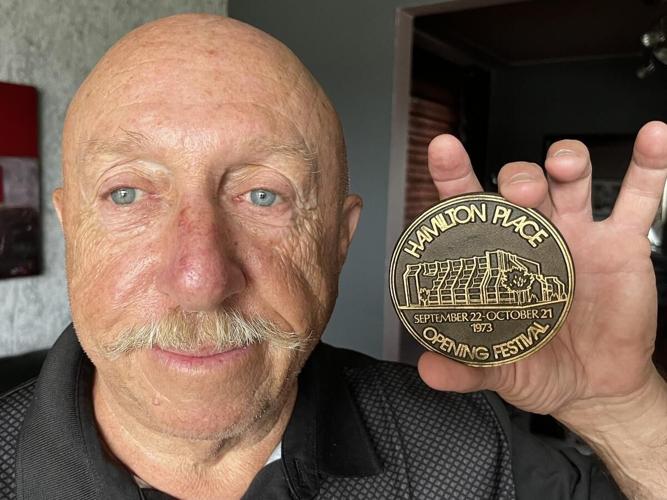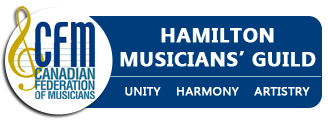by Mark McNeil, Hamilton Specator Contributing Columnist
I don’t think I have ever seen a job listing for a timpani player.
You know, the folks who sit at the back of an orchestra and bang like thunder a collection of big-barrelled, tunable drums.
Those jobs are few and hard to get.
And when somebody lands one, I imagine the drummer will want to hold onto it.
That probably goes some distance in explaining why 75-year-old principal timpanist Jean Norman Iadeluca has stayed on with the Hamilton Philharmonic Orchestra for a phenomenal 53 seasons.
And this Saturday, he will be in an especially unique position for the season-opening HPO concert that will celebrate the 50th anniversary of FirstOntario Concert Hall — the place that used to be called Hamilton Place.
Jean Norman is one of only two current HPO musicians who played at the inaugural concert on Sept. 22, 1973. The other is flutist Vivian Minden.

Timpanist Jean Norman Iadeluca holds up a medallion from the opening festival at Hamilton Place in September 1973. All Hamilton Philharmonic Orchestra musicians who took part in the festival were given the souvenir.
I’ve always been fascinated with the role of the timpani in an orchestra. If music is an interplay between rhythm and pitch, the kettledrum is notable for being able to do both.
So, I reached out to Jean Norman to find out a little more about the instrument and that first concert 50 years ago.
What was it like to be on the stage for the grand opening of Hamilton Place?
“It was very exciting. We were all looking forward to playing somewhere that was acoustically built for what we do. We couldn’t wait to have a place that the orchestra could call home,” he says.
Canadian composer Louis Applebaum had been commissioned to write a work he called “Place Setting, A Celebration for the Opening of Hamilton Place” that called for timpani rolls to set the piece in motion. Jean Norman recalls tuning his drums to Bb to match the sound of the building’s sound banners that rose into the ceiling. The banners were designed to adjust the acoustic dynamics of the room according to the audience size. They are lowered with a small crowd or moved into the upright position when there is a full house, which is what happened on opening night in 1973.
Musicians of the orchestra joined Jean Norman on stage in a gathering flurry of music. The concertmaster Marta Hidy, and members of the violin section, woodwinds, and the brass section all came on separately, each playing their instruments. Then finally conductor Boris Brott appeared. The work segued into O Canada, with the audience singing along.
“I thought the piece was such a great way to introduce the orchestra and the building at the same time,” says Jean Norman.
It was symbolic in terms of how Hamilton Place and the HPO were built, piece by piece, over the years. And Applebaum’s work highlighted how an orchestra and a building could play together in harmony, something that was frustratingly unachievable with other venues that had been used by the HPO prior to the opening of Hamilton Place.
The orchestra had hosted concerts in the Palace Theatre on King Street, as well as the auditorium at Mohawk College, among other places.
“We were so lucky to have Hamilton Place,” says Jean Norman. “The hall is phenomenal for its acoustics. It is as good as any hall that I have played in. I’ve played in Canada and the United States, in Japan and Korea. And I wouldn’t trade it for anything.”
He says the audience can see the whole orchestra from any seat and hear each of its sections. “There are no bad seats in the Great Hall.”
The acoustics on the stage are phenomenal as well, making it easy for musicians to hear one another. As for his timpani setup, he says he thinks of it like the subwoofer in a home stereo system. It makes a big difference where it is placed in the room. He finds the centre, back of the stage is the best place for him to be.
Megan Nourse, the community engagement manager for the HPO, has been researching the history of the concert hall for online postings and a 50th anniversary display that will be featured at Saturday’s concert.
Reading newspaper coverage in The Spectator and Toronto newspapers from the time, she says, it was clear “the community really rallied behind the concert hall being built. There was a commitment from the whole community.”
Then-mayor Vic Copps and his predecessor Lloyd D. Jackson were strongly supportive, as was Brott, who had been HPO music director since 1969. People who stepped up in the community included Marnie and Larry Paikin, as well as Betty Webster, who became executive director of the orchestra.
Federal and provincial government funding wasn’t available. So, the community pressed forward on its own to raise nearly $11 million, with $8 million from the City of Hamilton and $3 million from fundraising. “The city’s leadership was behind it 100 per cent and that helped to rally citizens. Businesses came forward. There were payroll deductions from Stelco and Dofasco and other companies to raise funds,” says Nourse.
The renowned Trevor Garwood-Jones was commissioned as the architect, with Russell Johnson Associates of New York hired as acousticians.
The project was seen as a way to help enhance the image of the city, to take Hamilton to the next level.
“I think there was a strong understanding for a long time that Hamilton was more than its reputation. It was more than an industrial city,” says Nourse.
The project had many challenges, but the biggest controversy turned out to be about the sourcing of bricks. Sound- reflecting bricks were arranged like sideways pyramids on the walls to help direct the sound around the Great Hall. The acoustician wanted a specific brand from Ohio because studies showed its bricks were the best for sound quality. But many civic leaders insisted on a Canadian supplier.
In the end, the American bricks were used on the inside where acoustic attributes mattered. And Canadian bricks were used on the exterior.
Mark McNeil is a retired, award-winning Spectator journalist who writes about local history and heritage as a contributing columnist. Mark is also a celebrated singer-songwriter and storyteller who performs shows that feature his songs about characters and events from Hamilton’s past that are often the focus of his “Flashbacks” column.
